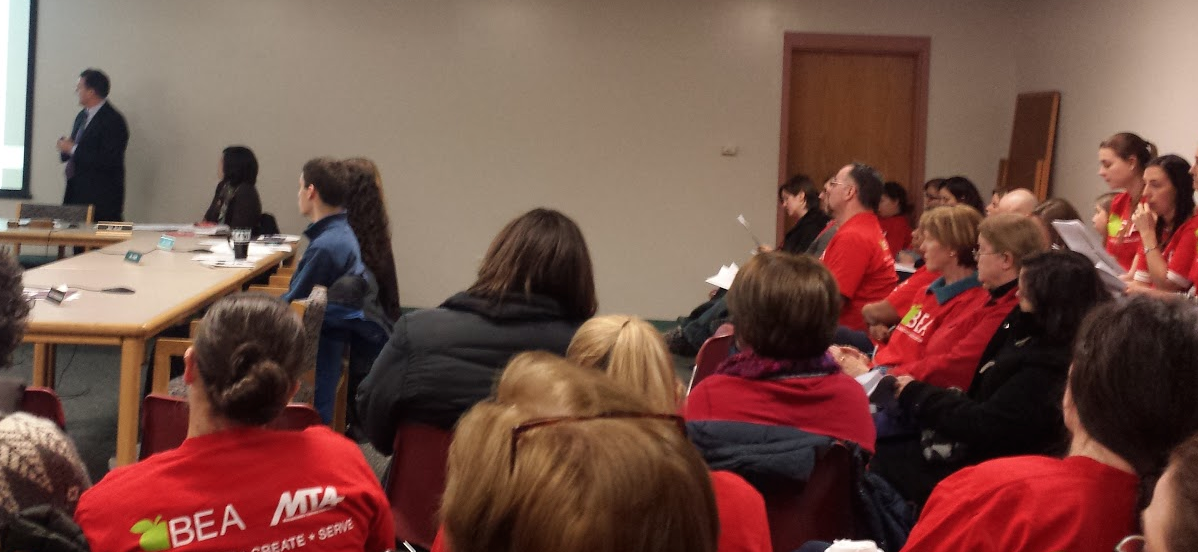Photo: Teacher and staff represented by the Belmont Education Association listening to District Superintendent John Phelan present the fiscal 2016 school budget to the Belmont School Committee on Wednesday, Feb. 11.
Belmont students will face “significant and negative impacts” if the Belmont School Committee approves an available revenue budget for the next fiscal year leaving the town’s top-rated schools with an anticipated $1.7 million shortfall, according to Belmont District Superintendent John Phelan.
The current budget would force Phelan to eliminate up to 22 full-time positions including teachers and staff, allow classroom sizes in all grades to exceed the School Committee’s own benchmarks for effective teaching and increase the number of “frees” and study halls for middle and high school students.
“It would be problematic for the district to function as a Tier 1 district under this budget,” Phelan told the Belmontonian Thursday, Feb. 12.
Making the first public presentation of the fiscal 2016 budget before the School Committee and approximately 75 teachers and staff at the Chenery Middle School, Phelan presented an overview of its fiscal year 2016 budget in which the district would run on the best estimates of the available revenue from state and town sources.
Under the town’s estimates, the schools will receive $47.5 million in fiscal ’16 under the current Town Meeting approved 58/42 budget “split” in which the district receives 58 percent of total revenues.
Belmont is already doing a great deal of what it has, said Phelan. Where the average annual expenditure per student statewide is $14,571, Belmont has become an educational destination for homebuyers spending roughly $12,800 a year.
In the presentation, Phelan told the committee the district finds itself facing several “pressure points,” the most immediate is the skyrocketing increase in enrollment. In just the past five years – 2009 to 2014 – the student population in kindergarten to 12th grade has increased by 317 students to 4,222 in October, 2014.
And the forecast is that an additional 408 students will enter the district by 2019, a ten-year increase of 723 pupils. For comparison, the Wellington Elementary School has approximately 440 students.
Phelen said the increasing population has also bumped up the number of students requiring assistance in English Language learning by nearly double in two years, 117 in 2013 to 222 in 2015. Because about 80 of those students are not very proficient in English, the state requires Belmont to hire new staff to provide 2.5 hours of “small group instruction.”
Also in the overall population is a growing number special education students. The major component of the current year’s $500,000 school deficit is nearly $950,000 in unanticipated costs associated with special education. And those costs will increase in fiscal 2016 with the rising number of students entering the district.
When calculating the new costs required to the current “pressure points” and moving the current level of staff and teachers into the new year, the schools will need $49.2 million just to “stay current.”
But with rising costs and stagnate revenue, Phelan said schools will be unable to meet the demands of the residents and students for a top-tier education as it attempts to fill the $1.7 million gap.
“With enrollments going up, and the number of positions staying steady if not being reduced, I would be hard pressed to say we can continue what we are doing,” Phelan told the Belmontonian.
The cuts would be deep and substantial: 22 full-time positions from teaching, staff and aids would be cut, a further reduction in material and supplies, trimming professional development, forego building maintenance, increase the fees to rent school property and a large increase in student and family fees for sports, clubs and full-time kindergarten.
What isn’t seen in the cost cutting will be more students in each classroom, less programs and idle teens “sitting on benches in the high school and in study halls at the Chenery,” said Phelan.
“This can only negatively impact student learning.”
The solution in Phelan’s eye and, in previous discussions with the School Committee, is to enthusiastically support the proposal outlined last month by the Financial Task Force to request the Board of Selectmen to place a three-year, $4.5 million Proposition 2 1/2 override on the ballot to fund the enrollment issues facing the district.
“That is the solution,” he said.
John Sullivan, a Palfrey Road resident, Belmont teacher and president of the Belmont Education Association which represents district teachers in union negotiations, told the board that despite a highly trained and capable staff, class size impacts the day-to-day experience of students.
“If Belmont wants to maintain a high-quality student experience, one that puts Belmont High in the top 10 percent of high school state-wide, then the fiscal year ’16 budget, and future budgets, need to address the increase in enrollment,” said Sullivan.








John Phelan is so right. It took decades for Belmont’s schools to become top tier. At the rate we are going we will be third tier soon. Once the parents of high potential students move out, and they will, the biggest economic engine in Belmont will sputter to mediocrity and property values will quickly follow the schools down. This is not theory. This pattern has happened over and over in short sighted communities that have not invested in their future.